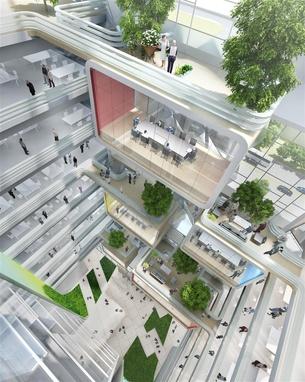Most environmental resources do not, formally, have a recognized market price, however it is generally recognized that nature provides free goods and services that are important to our society, many of which are essential for our survival. This is the basis of so-called ‘green economy’.

Going green has become very attractive as a business strategy, with the birth of many new terms such as green politics, sustainability, renewables, ecological footprints and many others, including the phrase, well known in our industry, of ‘green building’.
The term ‘green building’ was first coined in the 1970s by architects and environmentalists. It can also be known as ‘green construction’ or ‘sustainable building’.
In an environmental context, being green means being at peace with nature, not attacking her. Applied to architecture, a green building, then, is that designed, built and maintained with minimum consumption of water and energy, giving priority to materials that do not pollute the environment during their production and do not harm the health of users.
With the growth of the environmental movement, strict environmental legislation and foreign investors keen to invest in high quality sustainable projects, environmental management has become more important than ever.
There are two reasons why green building is becoming increasingly important for the industry:
1) green building technologies and resources are getting cheaper, thanks to technological advances, mass production and market competition
2) whether fuelled by the green trend or by a real need to reduce their footprint, people want to be more green.
The following list of ten trends distils Smart Electrician’s thinking about green building and many similar issues over the past year and forecasts what will shape the sustainable development agenda in the next year:
1. Exponential growth of the green commercial real estate market: This will be seen in both the commercial and corporate sectors and will be increasingly replicated with government buildings, universities, non-profit offices and schools under construction.
Some of the reasons for this range from increasing numbers of institutional investors, changes in state and municipal laws, commercial tenants’ demands, tax credits and incentives, total operating costs and green building studies.
Public and commercial buildings are responsible for 40% of global energy use, mainly driven by heating, cooling and lighting. Products from companies such as Philips including energy efficient LED lighting combined with smart controls, can save up to 70% in lighting energy costs each year.
2. Convergence between Business Management Systems and IT: Energy efficiency measures in buildings are being more widely adopted. This will continue on a larger scale in corporate and commercial real estate, but this year the trend will incorporate government buildings, education and housing. The role of automation will be the cornerstone of these strategies, which aim to maximise the energy efficiency, safety, and comfort of buildings, all using cloud-based services.
3. Operational transparency: The public availability of all information concerning the performance of green buildings will be a trend driven by government programmes worldwide.
4. Design and operation of Zero Emissions (Net-Zero) buildings: It is a fact that green buildings are the foundation of the modern construction and lighting industry but in order to distinguish between projects, many owners and developers of buildings have now taken the next step that is having buildings that are completely self-sustainable by producing the energy they need for their operation from renewable sources rather than relying on fossil fuel.
5. Photovoltaic systems: The use of solar energy in commercial applications continues to grow. Considered a viable and cost-competitive energy alternative to traditional fossil fuel energy sources, solar will continue growing - providing capital for rooftop solar systems in low-rise commercial buildings, parking lots, warehouses and retail stores as well as in homes.
6. Integration of Smart Cities: More and more buildings will be connected to electricity grids bidirectionally, creating an intelligent or ‘smart’ grid network. Both buildings and utilities can optimise their power management capabilities.
7. Retrofit in existing buildings: The focus of the green building industry will no longer only be new buildings, instead retrofitting, or technical renovation, will be used more in existing buildings. This is expected to mark the beginning of a new era with lighting products taking the main stage.
8. Blue is the new green: Better use of water, inspired by the increasing awareness of the global crisis in fresh water supply, which is expected to increase as global climate change continues to affect precipitation systems and water supply worldwide.
9. Administration in the cloud: Green buildings will be designed and managed by increasingly innovative information technology platforms based in the cloud. Collecting the required materials to build a green project can be a challenge when availability in the market is quite scarce, Cloud-based platforms will help everyone to manage and archive materials. Many construction projects are being undertaken on a daily basis globally, and managing these can be an arduous task for those who are working in a cross-country team. This is where cloud computing can help - connecting distant individuals, enabling a more synchronised cooperation.
10. Electric vehicles: As of September 2015, there are over 30 models of highway legal all-electric passenger cars and utility vans available for retail sales, mainly in the United States, China, Japan, and Western European countries. The automotive industry has made it clear that electric vehicles are a reality, but there is no optimal infrastructure for them yet. Worldwide, more and more companies, governments and regulators work on comprehensive programmes to promote sustainable mobility, such as charging stations in commercial and corporate buildings.
When it comes to sustainability and green building, we’ve made important progress as an industry over the last decade, but even more important is the work that lies ahead. Across the lighting and construction sector, we need to recognise the importance of each trend and how to future proof to incorporate these new trends as necessary.
Please let us know your thoughts in the comment section.
